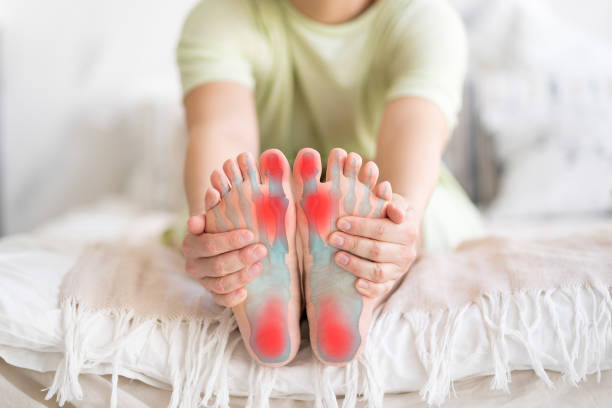As parents, we often find ourselves marveling at every tiny detail of our child’s development, and rightly so. From their first smile to their first steps, every milestone is a cause for celebration. However, amidst all the excitement, it’s essential to pay attention to our little one’s feet, as they play a crucial role in their overall development and well-being. In this comprehensive guide, we’ll explore when to be concerned about your child’s feet and what signs to look out for.

Normal Development
Before diving into potential concerns, let’s first understand what constitutes normal development in children’s feet:
- Birth: At birth, a baby’s feet might appear flat due to the thick layer of fat that typically fills the arch area. Additionally, their feet may appear turned inwards due to the cramped position in the womb. Both of these are normal and usually resolve within a few months.
- Infancy: As babies start to explore movement, their feet will naturally develop. They may start pushing up on their toes, rolling from side to side, and eventually crawling. This exploration helps in strengthening the muscles and ligaments in their feet.
- Toddlerhood: Once your child starts walking, you may notice a wide range of walking patterns, including toe-walking, flat-footedness, or walking with turned-in or turned-out feet. These variations are typically normal and tend to correct themselves as your child’s muscles strengthen and coordination improves.
When to Be Concerned
While many variations in foot development are normal, there are certain signs that may indicate a potential issue requiring further evaluation:
- Persistent Toe-Walking: While occasional toe-walking is common, if your child consistently walks on their toes beyond the age of three, it may signal an underlying issue such as tight Achilles tendons or sensory processing concerns.
- Flat Feet: Flat feet, or pes planus, are common in children and often resolve as they age. However, if your child’s flat feet cause pain, or difficulty walking, or if they have rigid flat feet (where the arch doesn’t reappear when the foot is lifted), it’s essential to consult a podiatrist Mitchelton.
- Foot Pain: Any complaints of foot pain, especially if they affect your child’s ability to participate in activities or cause limping, should not be ignored. Foot pain could be due to a variety of issues such as fractures, growth plate injuries, or structural abnormalities.
- Uneven Shoe Wear: Pay attention to how your child wears out their shoes. Significant wear on one side or the heel of the shoe may indicate an imbalance in their gait or foot structure.
- Delayed Milestones: If your child is significantly delayed in achieving motor milestones such as standing, walking, or jumping, it may be worth discussing with your pediatrician or a pediatric orthopedic specialist.
When to Seek Professional Help
If you notice any of the above signs or have concerns about your child’s foot development, it’s crucial to seek professional evaluation. A podiatrist The Gap or orthopedic specialist with experience in treating children’s foot issues can provide a thorough assessment and appropriate guidance.
During the evaluation, the healthcare provider may perform a physical examination, assess your child’s gait, and recommend imaging studies such as X-rays or MRI scans to further evaluate the structure of the feet and ankles.
Treatment Options
Treatment for foot issues in children varies depending on the underlying cause and severity of the condition. It may include:
- Physical Therapy: Exercises and stretches to strengthen muscles and improve flexibility.
- Orthotics: Custom-made shoe inserts to provide support and correct alignment.
- Bracing: In some cases, a brace or splint may be prescribed to help correct foot position.
- Surgery: In rare instances where conservative measures are ineffective, surgical intervention may be necessary to correct structural abnormalities.
In the grand adventure of parenthood, nothing is more precious than the well-being of our children. From their very first breaths to the milestones they conquer, every step they take is a testament to their incredible journey of growth. Amidst this journey, their tiny toes play a monumental role, serving as the foundation upon which they explore the world.
As we navigate the intricate path of child-rearing, it’s imperative to remember that while many nuances in foot development are entirely normal, some subtle signs may hint at underlying issues that require attention. By remaining vigilant and attuned to the subtle cues our children provide, we empower ourselves to address concerns proactively, ensuring their feet serve them well throughout their lives.
Early intervention emerges as a beacon of hope in the face of potential foot concerns. Seeking professional evaluation at the first sign of worry grants us the opportunity to intervene swiftly, guiding our children toward optimal foot health and function. Whether it’s a quick consultation with a pediatric podiatrist or a comprehensive assessment by a pediatric orthopedic specialist, every step taken in pursuit of our child’s well-being is a stride toward a brighter, healthier future.
It’s crucial to embrace the uniqueness of each child’s journey. What may be considered typical for one may deviate from the norm for another. Trusting our instincts as parents, we embark on a journey of advocacy and support, championing our children’s needs and ensuring they receive the specialized care they deserve.
Every thread contributes to the rich fabric of our children’s lives. Their tiny toes symbolize the beginning of a magnificent odyssey, one filled with boundless possibilities and infinite potential. Let us pledge to nurture and protect these precious appendages, for they are the steadfast companions that will carry our children through their wondrous voyage of growth and exploration. In doing so, we equip them with the greatest gift of all: the assurance that they are loved, supported, and empowered to conquer every step of their journey, one tiny toe at a time.
